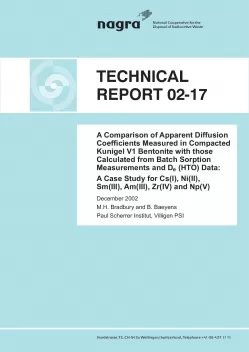
Technical Report NTB 02-17
A Comparison of Apparent Diffusion Coefficients Measured in Compacted Kunigel V1 Bentonite with those Calculated from Batch Sorption Measurements and De (HTO) Data: A Case Study for Cs(I), Ni(II), Sm(III), Am(III), Zr(IV) and Np(V)
Recently, a bentonite sorption data base, comprising values taken from batch sorption data, was developed for a performance assessment study for highlevel waste and spent fuel (Entsorgungsnachweis). Thus distribution coefficients (Kd) determined on dispersed systems were used to calculate apparent diffusion coefficients (Da) subsequently applied in diffusive transport calculations for the highly compacted system. Whenever such a procedure is adopted, questions invariably arise as to whether this is conservative or not.
On the occasions when Kd values have been extracted from (mainly) indiffusion experiments and compared with those obtained from batch tests, apparent discrepancies have been found. In the majority of cases the batch values are larger, sometimes significantly. Hypotheses from "surface diffusion" to "double layer pore constrictivity effects" have been proposed to explain the inconsistencies. However, although such discrepancies have been reported periodically over the past twenty years or so, and have become generally accepted facts of life, there are surprisingly few quantitative studies directly dealing with this issue. Further, two other points are worthy of mention. The first is that a diffusion model (including the associated assumptions) is needed in order to deduce Kd values from diffusion measurements. Thus the sorption values calculated are model dependent. The second is that too little attention has been paid to the potential effects of water chemistry, i.e. a comparison between sorption values is only valid when the water chemistry in the batch tests is the same as, or very close to, the porewater chemistry in the intact material. In practice, this condition is difficult to achieve because of the uncertainties concerning the latter.
This report describes a study in which Kd values for Cs(l), Ni(ll), Sm(III), Am(lll), Zr(IV) and Np(V) were calculated from in-diffusion data published in the open literature for a Na-bentonite (Kunigel V1) at dry densities between 400 and 2000 kg m-3. The range of oxidation states of the elements considered provides a good representation of those expected in a radioactive waste repository.
A porewater chemistry was calculated for each dry density and used in conjunction with sorption models and/or sorption data from batch measurements to produce blind predictions for Kd values for the compacted Kunigel V1 bentonite. These Kd values combined with effective diffusion coefficients (De) for tritiated water (HTO) were used to calculate Da values as function of dry density and compared with the corresponding Da values from diffusion measurements.
An important motivation for this study was to see whether discrepancies did in fact exist between calculated and measured Da values originating from batch and diffusion experiments when "state of the art" knowledge concerning sorption processes and bentonite porewater chemistry was applied to a specific system.
The preliminary conclusion drawn is that, in general, the differences between Da values calculated from batch Kd measurements and De (HTO) values, and those measured in-diffusion tests are not great. However, an important consideration is the bentonite porewater chemistry.
